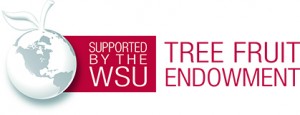Written by Shawn McMurtrey, Kartini Luther, Janet Turner, John Bennett, Rachel Leisso, June 2025
Mucor rot of pear and apple is caused by the fungal pathogen Mucor piriformis. Losses due to decay caused by this pathogen vary from year-to-year, with a “bad” Mucor year occurring approximately every 5 to 7 years.
A limited number of fungicides have been registered for use to control Mucor rot and novel approaches to mitigate losses are needed. In 2023 and 2024, Shawn McMurtrey at the USDA-ARS Hood River Worksite led a study evaluating the ability of ultraviolet light in the C spectrum (220 nm far UV and 265 nm UV-C) to inactivate M. piriformis sporangiospores in vitro and to reduce decay in wound-inoculated pear fruit.
In in vitro trials, both far UV and UV-C were able to inhibit germination of M. piriformis spores at an irradiance of 1.0 kJ • m-2 and to inactivate growth of M. piriformis in polystyrene wells (whose shape mimics a puncture wound on fruit) at an intensity of greater than 9 kJ • m-2. Effects of light treatments (0 kJ • m-2, 10 kJ • m-2, and 20 kJ • m-2) were also tested on ‘d’Anjou’ and ‘Bartlett’ pears that had been wound inoculated with ~100 M. piriformis sporangiospores. Neither light treatment reduced rot caused by M. piriformis in ‘d’Anjou’ and ‘Bartlett’ pears, likely due to occlusion of Mucor rot propagules from UV light penetration by the edges of the wound. The effects of UV radiation on fruit quality were also evaluated on non-inoculated fruit. Peel burn damage was apparent following 20 kJm-2 265 nm UV-C light treatment for both ‘Bartlett’ and ‘d’Anjou’, but the effects of 10 kJ • m-2 or 20 kJ • m-2 far UV were inconclusive or minimal, respectively.
In summary, study results indicate UV radiation is not suitable for directly mitigating wound-related Mucor rot decay in the pear fruit itself, given the lack of disease control by either far UV or UV-C. Given the duration (>3 min for either light) required for sporangiospore inactivation, the technology evaluated may be impractical for managing M. piriformis on moving surfaces in pear packing systems but has potential for disinfestation of stationary components. The far UV and UV-C doses required to inactivate M. piriformis reported here support further advances in ultraviolet radiation technology for postharvest pathogen control.

Contact
Rachel Leisso
Research Horticulturist (Postharvest)
USDA
Rachel.Leisso@usda.gov
